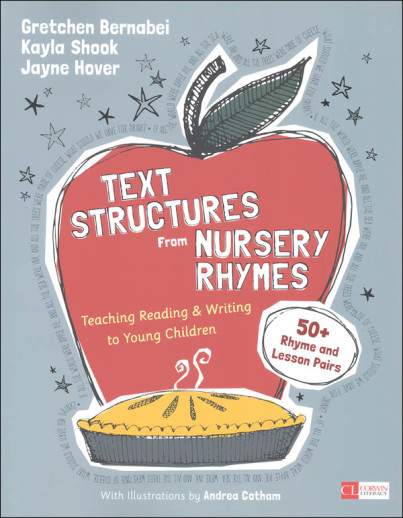We use cookies to make your experience better. To comply with the new e-Privacy directive, we need to ask for your consent to set the cookies. Learn more.
Text Structures from Nursery Rhymes
Taking a writing methodology that was pioneered with older students and adapting it to the needs of young writers, was the starting point for this book. First of all, the authors recognized that rhyming structures are extremely helpful for emerging readers, and that most young students love the rhythm and rhymes of Nursery Rhymes. Then, they added another layer of appeal by providing a graphic translation of each rhyme and adapted the kernel essay approach to a pictures-into-kernel methodology. The result is a collection of 53 text structure lessons for kindergarten through third graders all based on nursery rhymes.
Based on teacher-student interaction, the lessons are similar to others in this series. They begin with a teacher's “Let's Write" page that provides prompts for students to think about, an introduction to the basic text structure for the rhyme, and an example kernel essay. At this K-3 level, this page also includes some basic grammar and spelling connections. So, looking at the lesson based on Hey Diddle Diddle, students are asked to think about a time when a lot of people were all doing different things at the same time. The prompt encourages students to think of doing things on a playground, at a party, in classroom center rotations, and in the cafeteria.
Reading the rhyme comes next and that is done multiple times: read aloud by parent/teacher; read and then echoed by students, and finally, read by students.
The basic text structure for the rhyme is:
What one person was doing
What another person was doing
What another person was doing
What another person was doing
The “Let's Read" student page includes the rhyme and a pictorial representation of the rhyme that corresponds to the text structure (so, four boxes). Students are encouraged to come up with their own set of happenings fitting into the same structure and centered around whatever topic was chosen. These can be dictated, illustrated and/or written by students. Included with the lesson are some student samples.
It's easy to see how you can move from a well-known children's rhyme to the outline for another story altogether, and the well-laid-out lesson plans make the whole approach pick-up-and-go. Some text structures are simpler with only two or three boxes providing a good starting place.
Appendices include the complete collection of 53 text structures, plus the same structures grouped according to topic. Also included are reproducible templates that include picture boxes and handwriting lines either with dotted middles (9/16") or without (5/16"). There are two, three, and four box templates. Finally, there are templates for completed stories with illustration boxes and lines. 250 pgs, pb. ~ Janice
"It's one of education's greatest challenges: How do we shape our youngest students, who often are just learning how to hold a pencil, into capable writers within the span of a single school year?
Text Structures from Nursery Rhymes offers the solution: a clear and actionable framework for guiding young students to write successfully in any style, from narrative to descriptive to persuasive.
The key to the strategy lies in using familiar text structures to break down a story into its main components for example, "Where I was, "Who I saw, and "What I thought in order to immediately thrust students into the role of the writer.
This groundbreaking book provides 53 lessons, each centered around a classic nursery rhyme, and all the tools you'll need to
- Capitalize on the story's rhythm and rhyme to make an instant connection with your students
- Convey the story's text structure using the lesson's whimsical illustrations, providing a visual model that resonates with children
- Lead the classroom in creating new stories in words, pictures, or both utilizing the text structure you've defined
- Put each nursery rhyme to work as a springboard for important language-arts topics
- Fine-tune your approach at every step based on your preferred teaching style and students' progress
Put Text Structures from Nursery Rhymes to work in your classroom and discover how text structures, already a remarkable success in later grades, can also have a profound impact on younger students' progress.
Bonus!
Includes eight downloadable paper dolls1 man, 1 woman, 1 girl, 1 boy, and 4 animals. Your students can use the paper dolls to retell the nursery rhymes, illustrate their own stories based on a nursery rhyme, or even to act out stories from other books in your classroom library.
These materials focus on providing writing practice and offer little to no instruction.
| Product Format: | Paperback |
|---|---|
| Brand: | Corwin Press |
| Grades: | K-3 |
| ISBN: | 9781506387963 |
| Length in Inches: | 11 |
| Width in Inches: | 8.5 |
| Height in Inches: | 0.625 |
| Weight in Pounds: | 1.7 |

